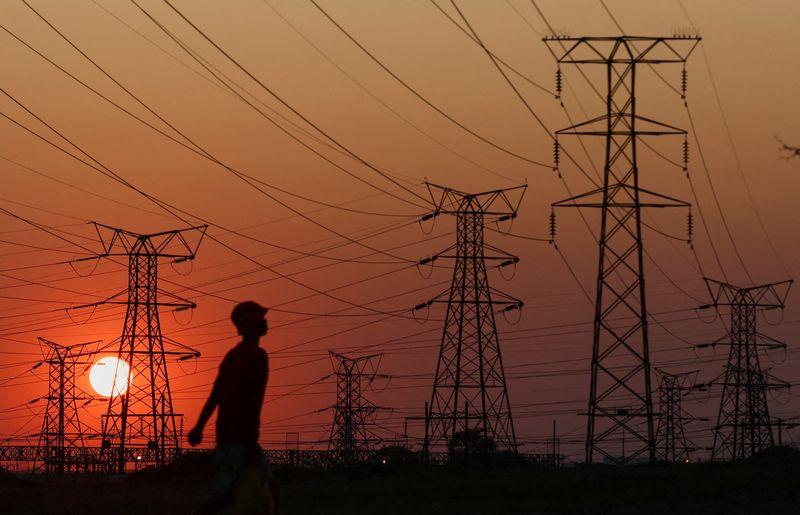
LITTLETON, Colo Nov 22 (Reuters) – African nations made clear at last week’s United Nations climate summit that the region would develop its fossil fuel resources to alleviate fuel shortages, help lift local populations out of poverty and spur vital economic growth.
Africa’s electricity consumption growth since 2017 was second only to top power consumer Asia, according to Enerdata, and is home to several countries that are expected to see favourable demographic changes and robust economic growth this decade, including Egypt, host of the latest COP27 climate talks.
This combination of a planned expansion in fossil fuel use and increased economic momentum and will raise fears among climate trackers that the region is set to accelerate pollution levels that may undermine climate change targets.
Yet the extent of any actual emissions increase will depend greatly on the source of power used to generate electricity in each country.
BENCHMARKS
In 2021, Africa as a whole generated 39% of its electricity from gas, 29% from coal, 8% from other fossil fuels, 17% from hydro, and 4% from renewable sources, according to data from Ember.
However, the power mix varies greatly by country depending on locally available power sources, legacy power production infrastructure, and proximity to energy exporters.
This wide variance in power mix is clear when comparing the electricity source profiles of Africa’s two largest electricity producers, South Africa and Egypt.
South Africa – Africa’s second largest economy after Nigeria – is primarily powered by locally-mined coal, which generated nearly 90% of the country’s total electricity supply of 224.63 terawatt hours (TWh) in 2021.
In contrast, Egypt uses natural gas for 77% of its electricity, and uses no coal in electricity generation at all. Egypt’s total electricity supply was 174.88 TWh in 2021, 28.4% less than South Africa’s total.
The two countries’ electricity systems have starkly divergent emissions footprints as a result of their different primary fuels.
South Africa emits more than twice the amount of carbon dioxide and equivalent gases than Egypt, and was the 12th largest CO2 polluter from energy in 2021, according to the latest BP Statistical review of World Energy. Egypt ranked 28th.
WIDE RANGE
With more than 50 countries in total, Africa’s power mix trajectory is hard to predict and will be determined by a slew of local and international factors including government spending levels, private investment and foreign aid.
However, the energy systems of the continent’s five largest economies – Nigeria, South Africa, Egypt, Algeria and Morocco – can provide clues as to what may be expected in different parts of the continent.
Across southern Africa, coal’s footprint in the power mix may be hard to dislodge over the near term.
Beyond South Africa, local economies including Botswana, Zimbabwe and Zambia are all heavy coal users, and boast significant coal mining sectors that are large employers and tax payers.
However, given the international support for helping countries transition away from dirty coal towards cleaner energy sources, several nations that currently rely on coal are expected to receive funding for efforts to switch to other fuels, which may serve to cap coal’s market share in the region.
A potential candidate to replace coal in several parts of Africa is hydro power, which has expanded by 50% across all of Africa since 2010 and is the primary source of electricity in both Zimbabwe and Zambia as well as Mozambique and Namibia.
New projects are in development in Ethiopia, Uganda, Tanzania, Zambia and Angola that will expand power supplies across several parts of eastern, central and southern Africa, according to the International Hydropower Association.
GAS SWITCH?
Across Northern Africa, natural gas is making rapid inroads into energy systems, primarily from the abundant local supplies in Algeria and Egypt.
In Western Africa, Nigeria is playing a pivotal role in expanding gas consumption after boosting production by roughly 50% since 2010 and signing deals for pipelined exports to other countries in the region.
One major potential customer of Nigerian gas is Morocco, Africa’s 5th largest economy which has grown by 20% since 2017.
Morocco currently relies on imported coal for nearly 60% of electricity production, but recently signed a pipeline deal with Nigeria which has the potential to allow Morocco’s energy producers to switch out high-emitting coal for cleaner-burning natural gas.
If this pivot away from coal can be replicated elsewhere along the proposed pipeline’s route through Ghana, Cote d’Ivoire and Sierra Leone, then Africa’s higher use of fossil fuels may not necessarily equate to the higher emissions feared by climate advocates.
Indeed, greater production and distribution of natural gas – along with the expansion of renewable energy sources – could allow some coal-dependent economies in Africa to actually cut use of the world’s dirtiest fuel, even as they increase overall energy consumption.
Electricity use by regionhttps://tmsnrt.rs/3gttLur
Electricity generation by source in key African economieshttps://tmsnrt.rs/3XzYCX5
Top 5 African economieshttps://tmsnrt.rs/3Vk5DZN
(Reporting By Gavin Maguire)

